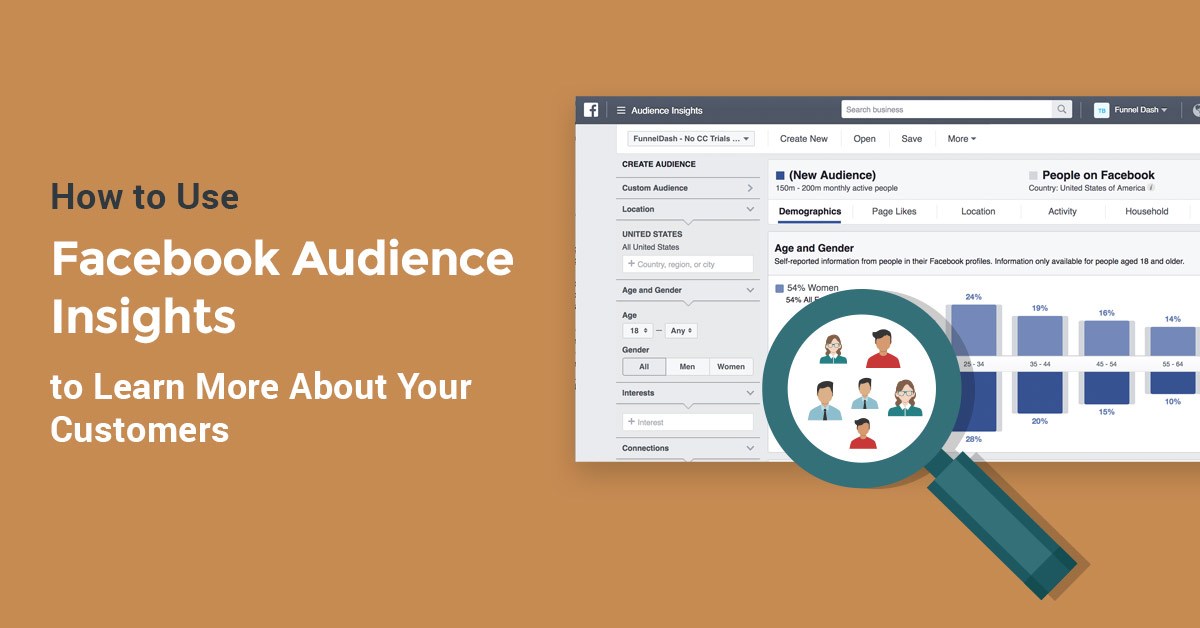Before you run any Facebook ad campaigns, it’s important to get to know your customer. Your ad targeting, your placement options, and your choice of offer can all be determined by the psychographics & demographics of your ideal customer.

Luckily, Facebook has a great tool that any advertiser can use to get to know the demographic and psychographic information of their prospects before they run a single ad (and help them refine their customer profiles after they’ve been running ads as well).
Read on, and I’ll show you how to use Facebook Audience Insights to gain practical knowledge about your prospects, and how that knowledge corresponds to different options for your Facebook campaigns.
Can You Answer These Questions About Your Customers?
Household income?
Age?
Gender?
Location?
Device Usage?
What TV shows, celebrities, books, causes, websites, products, and brands they like?
What industry they work in?
Once you begin to use Audience Insights, you’ll have answers to all these questions and more…
To start using Audience Insights, make a custom audience of your buyers by either uploading your email list into Facebook, making an audience of visitors to your purchase confirmation page, or making an audience of purchase events.

Add your audience of buyers into the box in the above screenshot to begin. The first tab you’ll want to look at is the demographics tab. This will tell you what percentage of the custom audience you’re looking at is a certain age, or certain gender, and what percentage of all Facebook users are as well.

If you scroll all the way down to the bottom of the demographics tab, you’ll get info on what job titles your audience is likely to have:

While Audience insights says, this is “Job Title” targeting, in power editor, this is actually industry level targeting.

The next tab I recommend you look at is the household tab. This screen will give you key income information about your customers, and help you refine your targeting further, especially if you sell high price point products.

Income targeting also shows up in power editor as well:

This is a great set of targeting to layer onto another piece of targeting, whether it be a lookalike audience or a broad interest.
By using the “narrow audience” feature in power editor, you can target users who have an income within certain ranges, and users who are interested specifically in “interest A.”
The next tab I would take a look at is “Activity” this will inform your placement targeting decisions for your campaigns:

The chart at the bottom will show you what percentage of your buyer audience uses desktop, mobile or mobile & desktop web. It will also show you what type of mobile devices your audience uses. The green or red percentages below the chart show if that portion of the audience is more or less likely than typical Facebook users to fall into that category.
Getting on Target Interests & “Right Angle” Interests
The last, and most important tab of audience insights you should familiarize yourself with is the page likes tab.


This tab is split out into two parts, categories of likes, and specific likes.
The “affinity” scores tied to specific likes at the bottom measure how likely someone in your audience is to like a specific page than everyone else on Facebook.
The higher the affinity score, the more relevant that interest is.
How to Use This Information
The main way we use audience insights for our clients, is doing demographic, interest and behavior research for clients who either haven’t run traffic before, or who need new targeting ideas to scale.
I like to group interests that I find in audience insights thematically when I test them. (Audience size permitting).
So, for the above example, we might group TV shows together in one interest bundle, websites in another, and “figures” in another.
Then once we test those three audiences, we’ll likely have 1-2 winners.
This is where “right-angle” targeting comes in.
Right-angle targeting is a term Perry Marshall uses in his “Ultimate Guide to Google AdWords”.
Right-angle targeting is simply an interest that your target audience is likely to have an affinity for, but isn’t related to your product directly.
After you’ve tested your initial set of interests you can simply plug them back into the “interests” box on the left-hand side of audience insights…
And voila! Now you have your right-angle interests.

Once you find a theme or group that works, keep expanding on that as much as makes sense.
Things to Note About Audience Insights
- If you don’t have enough buyers in your custom audience to see page like data, try a custom audience of leads.
- If you don’t have enough leads, try page likes.
- if you don’t have enough page likes, try competitors interests.
- Income targeting only reliably applies to US locations.
- Psychographic data changes based on the age range applied, if you know a specific audience converts for a specific demographic. Use those settings in audience insights to get the most relevant data.
Want to Learn More About Running Facebook Ads for Clients?
We’ll show you how having access to better data lets you run your campaigns more efficiently so you’re getting a better ROI for your clients. Plus, you’ll discover how easy it is to make these changes in your agency and how quickly you can grow to 7-figures using these techniques. Click on the button below to reserve your seat for our online masterclass, How to Build a 7-Figure Marketing Agency.
What Information Do You Get From Facebook Audience Insights?
Do you use Facebook Audience Insights differently that what we described above? Tell us about it in the comments.


